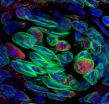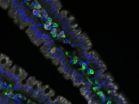Flipping a switch on neuron activity
Researchers in California and Germany demonstrate light-activated receptors on nerve cells
2011-03-08
(Press-News.org) WASHINGTON, D.C. (March 7, 2011) -- All our daily activities, from driving to work to solving a crossword puzzle, depend on signals carried along the body's vast network of neurons. Propagation of these signals is, in turn, dependent on myriad small molecules within nerve cells -- receptors, ion channels, and transmitters -- turning on and off in complex cascades. Until recently, the study of these molecules in real time has not been possible, but researchers at the University of California at Berkeley and the University of Munich have attached light-sensing modules to neuronal molecules, resulting in molecules that can be turned on and off with simple flashes of light.
"We get millisecond accuracy," says Joshua Levitz, a graduate student at Berkeley and first author of the study. According to Levitz, the "biggest advantage is that we can probe specific receptors in living organisms." Previous methods using pharmacological agents were much less specific, affecting every receptor in every cell. Now, investigators can select individual cells for activation by focusing light. And by attaching light-sensing modules to one class of molecules at a time, they can parse the contributions of individual classes to neuronal behavior.
Levitz will be presenting a system in which G-protein-coupled receptors, molecules that play key roles in transmitting signals within cells, can be selectively activated. He is planning to use the system to study the hippocampus, a region of the brain where memories are formed, stored and maintained. There may be clinical utility to the system as well, he points out. G-protein-coupled receptors are also critical for vision in the retina, and light-sensing versions could potentially be introduced into people with damaged retinas in order to restore sight.
###
The presentation, "Design and Application of a Light-Activated Metabotropic Glutamate Receptor for Optical Control of Intracellular Signaling Pathways" will be presented at 8:30 a.m. on March 7, 2011 in Room 309 of the Baltimore Convention Center. ABSTRACT: http://tinyurl.com/4lf9dse
The research was funded by the Nanomedicine Development Center at the National Institutes of Health.
MORE MEETING INFORMATION
Each year, the Biophysical Society Annual Meeting brings together more than 6,000 scientists and hosts more than 4,000 poster presentations, 200 exhibits, and more than 20 symposia. The largest meeting of its type in the world, the Biophysical Society Annual Meeting retains its small-meeting flavor through its subgroup meetings, platform sessions, social activities, and committee programs.
QUICK LINKS
Meeting Home Page:
http://www.biophysics.org/2011meeting
General Meeting Information:
http://www.biophysics.org/GeneralInfo/Overview/tabid/2062/Default.aspx
Search abstracts:
http://www.abstractsonline.com/plan/start.aspx?mkey={FEA830A5-24AD-47F3-8E61-FCA29F5FEF34}
PRESS REGISTRATION
The Biophysical Society invites credentialed journalists, freelance reporters working on assignment, and public information officers to attend its Annual Meeting for free. For more information on registering as a member of the press, please contact Ellen Weiss at eweiss@biophysics.org or 240-290-5606. Also see: http://www.biophysics.org/Registration/Press/tabid/2148/Default.aspx
ABOUT THE BIOPHYSICAL SOCIETY
The Biophysical Society, founded in 1956, is a professional, scientific society established to encourage development and dissemination of knowledge in biophysics. The society promotes growth in this expanding field through its annual meeting, monthly journal, and committee and outreach activities. Its over 9,000 members are located throughout the U.S. and the world, where they teach and conduct research in colleges, universities, laboratories, government agencies, and industry. For more information on the society or the 2011 Annual Meeting, visit www.biophysics.org
END
ELSE PRESS RELEASES FROM THIS DATE:
2011-03-08
Chinese people with a body mass index (BMI) of 24-25.9 had the lowest risk of death, according to a study published in CMAJ (Canadian Medical Association Journal) (pre-embargo link only) http://www.cmaj.ca/embargo/cmaj101303.pdf
Obesity has increased significantly across the globe and the World Health Organization (WHO) estimates that about 2.3 billion adults will be overweight and more than 700 million will be obese by 2015. Overweight and obesity are associated with increased risks of heart disease, diabetes, cancer and other chronic diseases.
As white populations ...
2011-03-08
Stroke patients who also suffer from an irregular heartbeat are at double the risk of developing dementia, according to a new study by the University of East Anglia (UEA).
Published tomorrow in the journal Neurology, the findings show that stroke survivors with an irregular heartbeat – or atrial fibrillation - are 2.4 times more likely to develop dementia than stroke survivors without the heart condition.
The researchers analysed 15 studies with more than 45,000 participants and an average age of 72. They compared patients with and without atrial fibrillation, and ...
2011-03-08
ST. PAUL, Minn. – Stroke survivors who have an irregular heartbeat called atrial fibrillation may be at higher risk of developing dementia than stroke survivors who do not have the heart condition, according to research published in the March 8, 2011, print issue of Neurology®, the medical journal of the American Academy of Neurology.
Atrial fibrillation affects more than two million Americans, and it is more common as people age. About 15 percent of strokes occur in people with atrial fibrillation. The heart's two upper chambers do not beat effectively in the condition, ...
2011-03-08
The Mediterranean diet has proven beneficial effects not only regarding metabolic syndrome, but also on its individual components including waist circumference, HDL-cholesterol levels, triglycerides levels, blood pressure levels and glucose metabolism, according to a new study published in the March 15, 2011, issue of the Journal of the American College of Cardiology. The study is a meta-analysis, including results of 50 studies on the Mediterranean diet, with an overall studied population of about half a million subjects.
"The prevalence of the metabolic syndrome is ...
2011-03-08
San Diego, CA, March 8, 2011 – In the 1960s, a group of U.S. states with high age-adjusted stroke mortality defined a "stroke belt." Until recently, geographic patterns of diabetes had not been specifically characterized in the same manner. In an article published in the April 2011 issue of the American Journal of Preventive Medicine, researchers were able to identify clustered high prevalence areas, or a "diabetes belt" of 644 counties in 15 mostly southeastern states using data compiled for the first time of estimates of the prevalence of diagnosed diabetes for every ...
2011-03-08
PHILADELPHIA (March 7, 2011) – A new research study dramatically increases knowledge of how taste cells detect sugars, a key step in developing strategies to limit overconsumption. Scientists from the Monell Center and collaborators have discovered that taste cells have several additional sugar detectors other than the previously known sweet receptor.
"Detecting the sweetness of nutritive sugars is one of the most important tasks of our taste cells," said senior author Robert F. Margolskee, M.D., Ph.D., a molecular neurobiologist at Monell. "Many of us eat too much sugar ...
2011-03-08
The intestinal epithelium consists of four main specialized cell lineages: absorptive enterocytes and three secretory cell types known as enteroendocrine, Paneth, and goblet cells. But a rare, fifth type of intestinal cell called tuft cells also exists. Defined by the thick brush of long microvilli that project from their apical surface, tuft cells are seen in several epithelial tissues, yet little is known about their function due to a lack of tuft cell–specific markers.
In the March 7 issue of The Journal of Cell Biology (www.jcb.org), a team of French researchers ...
2011-03-08
Patients with Parkinson's disease (PD) suffer a specific loss of dopaminergic neurons from the midbrain region that controls motor function. The exact mechanism of this selective neurodegeneration is unclear, though many lines of evidence point to dysfunctional mitochondrial complex I as one root cause of the disease. Yet new research now suggests that defective regulation of microtubules may be responsible for at least some cases of PD. The study appears in the March 7 issue of The Journal of Cell Biology (www.jcb.org).
Mitochondria were first implicated in PD when ...
2011-03-08
The immune system is capable of recognizing tumor growth, and naturally mounts an anti-cancer defense. Dendritic cells (DCs) can take up tumor-derived molecules (antigens) and present them to T cells, and those "primed" T cells are then able to recognize and kill tumor cells. In recent years, researchers have attempted to capitalize upon these natural immune responses to develop new therapies- namely, by generating a pool of tumor antigen-pulsed DCs that might be used as vaccines to augment the T-cell responses of cancer patients. In clinical trials, these DC vaccines have ...
2011-03-08
EDITOR'S PICK
Using a molecular switch to turn on cancer vaccines
The immune system is capable of recognizing tumor growth, and naturally mounts an anti-cancer defense. Dendritic cells (DCs) can take up tumor-derived molecules (antigens) and present them to T cells, and those "primed" T cells are then able to recognize and kill tumor cells. In recent years, researchers have attempted to capitalize upon these natural immune responses to develop new therapies- namely, by generating a pool of tumor antigen-pulsed DCs that might be used as vaccines to augment the T-cell responses ...
LAST 30 PRESS RELEASES:
[Press-News.org] Flipping a switch on neuron activity
Researchers in California and Germany demonstrate light-activated receptors on nerve cells


